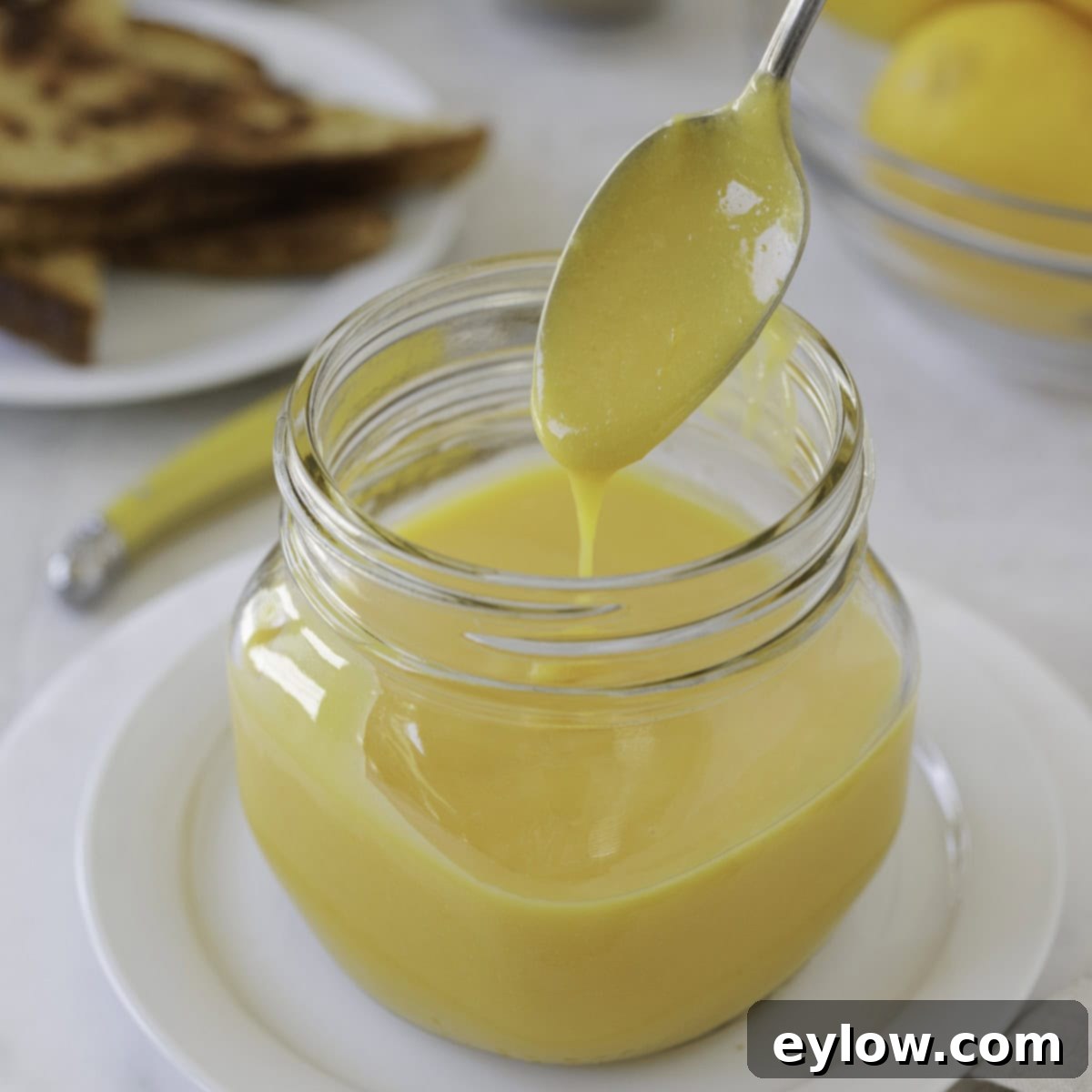Luscious Sugar-Free Keto Lemon Curd: Your Zesty, Low-Carb Indulgence
Discover the delight of a perfectly smooth, luxuriously creamy, and intensely bright lemon curd, crafted entirely without sugar! This incredible **sugar-free lemon curd** is not only a deliciously sweet treat but also naturally low-carb and perfectly keto-friendly. It’s an essential addition to any dessert lover’s repertoire, offering a vibrant burst of citrus flavor without the guilt. Imagine spreading it generously on keto toast, swirling it into your morning yogurt, or adding a refreshing zing to overnight oats. Versatile, incredibly easy to make, and boasting an authentic rich texture, this recipe is a true game-changer for anyone seeking a healthy yet decadent lemon experience. Be sure to explore our extensive ‘How to Use Lemon Curd’ section for a myriad of creative ways to enjoy this golden goodness!
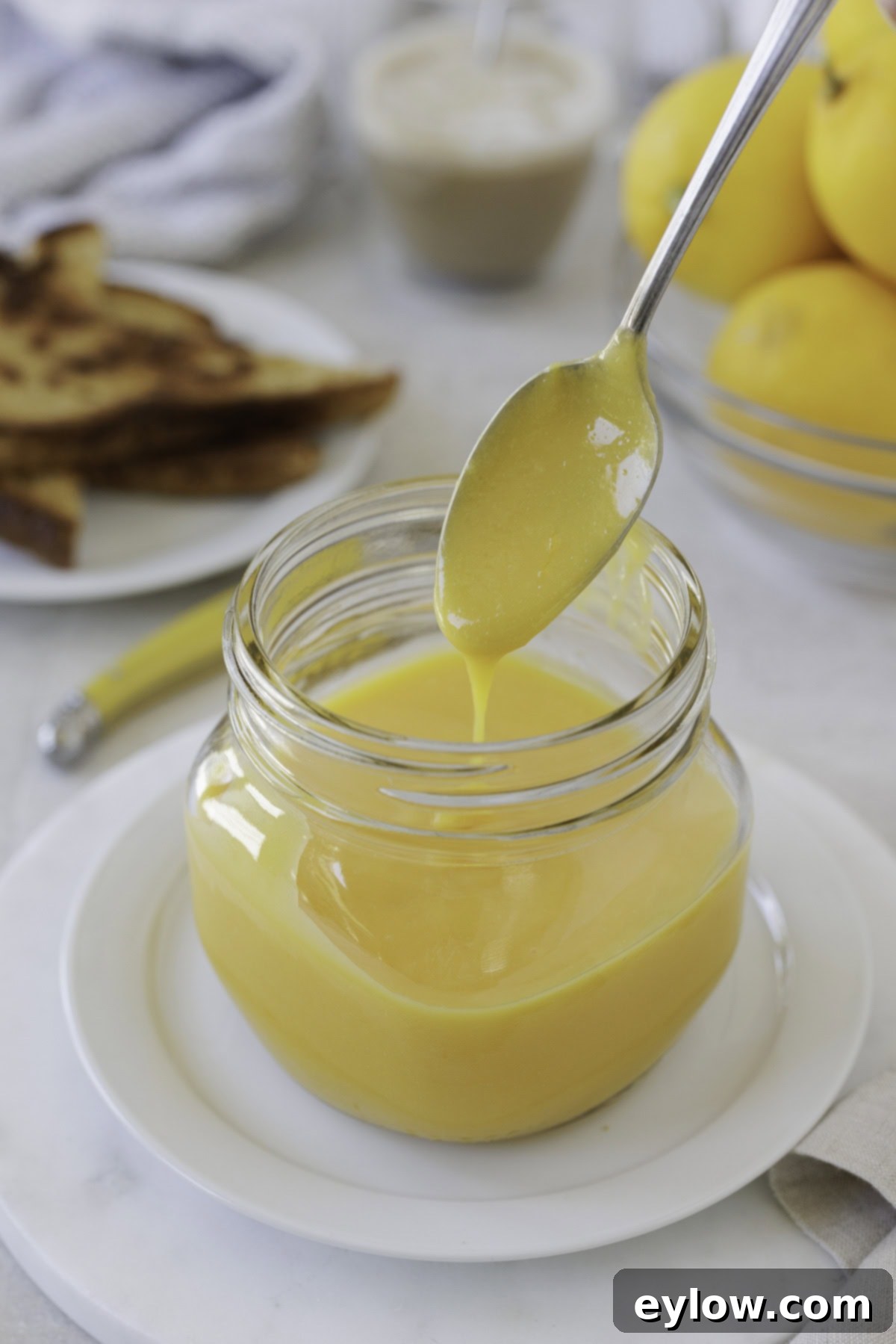
The colder months, particularly winter, mark the peak season for fresh lemons, making it the ideal time to whip up this easy and healthy lemon curd. Traditional lemon curd recipes rely on a simple combination of eggs, lemon juice, sugar, butter, and zest. However, our innovative sugar-free version meticulously replaces conventional sugar with powdered allulose. Achieving the perfect balance and texture took extensive experimentation and testing, but the results speak for themselves! This low-carb lemon curd is just as exquisitely smooth, wonderfully creamy, and bursting with bright, tangy citrus flavor as its sugary counterpart, all without any added sugar or compromise on taste. It truly is a keto lemon curd that tastes like the real deal.
[feast_advanced_jump_to]
Why This Sugar-Free Lemon Curd Recipe Will Become Your Favorite
This healthy dessert isn’t just a delicious treat; it’s a smart choice for anyone mindful of their sugar intake or following a low-carb or keto diet. Here’s why this sugar-free lemon curd stands out:
- Intense and Authentic Lemon Flavor: We utilize fresh lemon juice and zest to ensure a vibrant, tangy, and truly authentic lemon taste that brightens any dish. The natural acidity and aromatic zest are the stars here.
- Dietary Friendly: This recipe is entirely sugar-free, making it perfect for those managing blood sugar levels. It’s also a fantastic low-carb lemon curd and fully compliant with the keto diet, allowing you to enjoy a classic dessert without derailing your health goals.
- Simple Ingredients, Effortless Preparation: You won’t find any obscure or complicated items here. With just a handful of basic ingredients and straightforward steps, you can create a gourmet-quality lemon curd right in your own kitchen.
- Zero Blood Sugar Spike: Thanks to the use of allulose, this lemon curd boasts an impressively low 1 net carb per serving. This means you can indulge in its creamy goodness without worrying about unwanted blood sugar fluctuations.
- Customizable Consistency: Whether you prefer a thick, spoonable curd perfect for filling tarts or a slightly more pourable sauce to drizzle over desserts, this recipe can be easily adjusted to achieve your desired consistency.
If you’re a true lemon enthusiast, you’ll also adore this tasty, high-protein Mediterranean lentil quinoa salad, bursting with a tangy lemon vinaigrette.
Essential Ingredients for Your Keto Lemon Curd
Crafting the perfect sugar-free lemon curd starts with understanding each ingredient and its role. Here’s a closer look at what you’ll need:

- Lemons: The cornerstone of our lemon curd! You’ll need fresh lemons for both their bright, tangy juice and their aromatic zest. Standard Eureka or Lisbon lemons are generally ideal due to their consistent acidity. Meyer lemons can also be used, but they require a slight adjustment as noted below. Always choose firm, unblemished lemons with smooth, bright yellow skins for the best flavor and juicing results.
- Sweetener: For this sugar-free version, we exclusively recommend pure powdered allulose. It is crucial to use a pure powdered form, not a blend that may contain other sweeteners like monk fruit or erythritol. Powdered allulose dissolves beautifully and prevents any grainy or crystallized texture, ensuring your curd remains wonderfully smooth. Its unique molecular structure means your body doesn’t metabolize it, resulting in zero net carbs and no blood sugar spike.
- Butter: Use high-quality unsalted butter. Butter is essential for giving the lemon curd its signature rich, velvety texture and adds a delightful depth of flavor. Unsalted butter allows you to control the overall saltiness of your dish; no additional salt is needed for curd.
- Eggs: This recipe calls for large eggs, specifically the yolks. Egg yolks are vital for thickening the curd and imparting its beautiful golden color and custardy richness. Ensure your eggs are fresh and free from cracks. For an extra rich and decadent lemon curd, some recipes even use a higher ratio of yolks to whole eggs, but our recipe strikes a perfect balance.
- Powdered Citric Acid: This ingredient is ONLY necessary if you opt to use Meyer lemons. Meyer lemons have a naturally lower acidity (higher pH) compared to standard lemons. Without the addition of powdered citric acid, your curd may not set properly and could remain too thin. A mere ¼ teaspoon is typically enough to compensate and ensure a beautifully set curd.
Please refer to the detailed recipe card at the end of this article for precise measurements and comprehensive instructions.
Don’t let those leftover egg whites go to waste! Transform them into a batch of these easy chocolate chip meringues – a light and airy treat.
Customizing Your Sugar-Free Lemon Curd
This adaptable recipe allows for several adjustments to suit dietary needs or personal preferences:
- Using Meyer Lemons: As mentioned, if you choose the sweeter, less acidic Meyer lemons, a ¼ teaspoon of powdered citric acid is a must. This will provide the necessary acidity to ensure your curd sets correctly and achieves the desired tangy flavor profile.
- Butter Alternatives (Dairy-Free): For a dairy-free lemon curd, you can substitute unsalted plant-based butter (ensure it’s suitable for baking) or coconut oil.
- When using coconut oil, you have two options: melted unrefined coconut oil, which will impart a subtle coconut flavor that may slightly alter the taste of the lemon curd, or liquid/refined coconut oil, which is neutral-flavored and won’t affect the lemon taste. Be aware that using coconut oil may result in a slightly softer consistency, but the curd will still be wonderfully smooth and rich.
- For a Truly Smooth Curd: If you prefer a lemon curd with an absolutely silky, uniform texture, you can choose to omit the lemon zest. While the zest adds a beautiful aromatic intensity, leaving it out will result in a perfectly uniform consistency.
- Add a Hint of Vanilla: A touch of pure vanilla extract (about ½ teaspoon) added at the very end can complement the lemon flavor beautifully, adding another layer of complexity to your curd.
- Lime or Other Citrus Curd: While this recipe is for lemon, you can adapt it for other citrus. See our Chef’s Tip below for more on this!
If you’re fond of luscious lemon desserts, be sure to try this elegant lemon posset recipe (a no-bake delight!) or this fantastic lemon almond polenta cake, which is also gluten-free.
Chef’s Note on Sweeteners: Understanding Allulose
What exactly is allulose? Allulose is a naturally occurring rare sugar, found in small quantities in various natural sources like figs, raisins, wheat, maple syrup, and molasses. Unlike common sugar alcohols such as xylitol or erythritol (which we generally don’t recommend for their potential digestive side effects or cooling sensation), allulose is a truly unique sweetener. It tastes very similar to sugar, without any noticeable aftertaste, and behaves similarly in baking. While the nutrition label on a bag of allulose might list carbohydrates, your body does not metabolize these carbs. When factoring this in, a serving of this sugar-free lemon curd contains only 1 gram of net carbs, making it an excellent choice for a low-carb and keto lifestyle. It’s a truly terrific alternative sweetener, offering sweetness without the caloric impact or glycemic spike. For more detailed information on allulose and its benefits, you can refer to resources like the Cleveland Clinic.
Does the Type of Lemon Affect Your Curd? Yes!
Through extensive testing, experimenting with both standard Eureka and Meyer lemons, different ratios of egg yolks to whole eggs, and various sugar-free sweeteners, we’ve identified the optimal conditions for the best results. The type of lemons you choose and the specific sugar-free sweetener used play a significant role in how well your lemon curd sets and its final flavor profile.
Standard Eureka or Lisbon lemons are highly recommended for this recipe. Their naturally higher acidity (lower pH) is crucial for the chemical reaction that allows the eggs to thicken and set the curd properly, resulting in a firm and stable consistency.
Meyer lemons, while delicious and slightly sweeter, possess a lower acidity (higher pH). This means that if you use Meyer lemons without adjustment, your curd will likely remain softer, more akin to a pourable lemon sauce than a firm curd. If you opt for Meyer lemons, you absolutely must add a small amount of powdered citric acid to boost the acidity and ensure proper setting. Even as a pourable sauce, it’s still wonderfully tasty!
When it comes to thickening and setting, it’s best to trust the natural properties of the lemon juice and the gentle heat. We explored adding thickeners like xanthan gum to a batch that turned out too thin, but it unfortunately resulted in an undesirable gummy texture. The key is precise cooking temperature and the right lemon type.
Step-by-Step Guide: Making the Best Sugar-Free Lemon Curd
Never made lemon curd before? Don’t worry! These detailed step-by-step photos and instructions will guide you through the process of creating the most exquisite sugar-free lemon curd, ensuring a perfectly smooth and flavorful result every time.
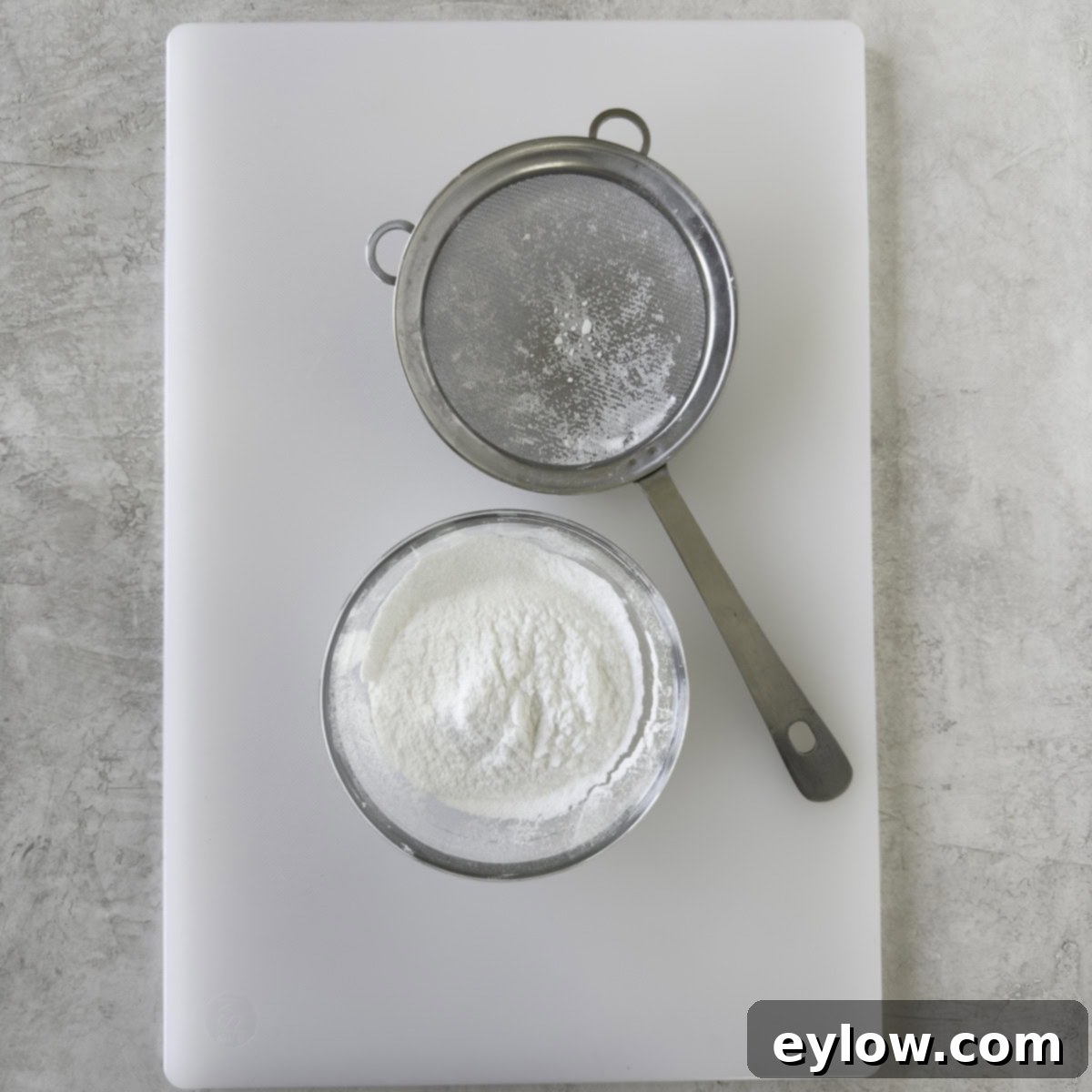
- Sift the Powdered Allulose: Begin by sifting your pure powdered allulose. This crucial step removes any potential clumps or “rocks” that can form in the bag, ensuring a completely smooth and lump-free curd.

- Prepare Ingredients: Zest your lemons first, then juice them. It’s much easier to zest a whole lemon. Next, separate the eggs, reserving the yolks for the curd and setting aside the whites for another use. Finally, cube the unsalted butter so it melts more evenly.
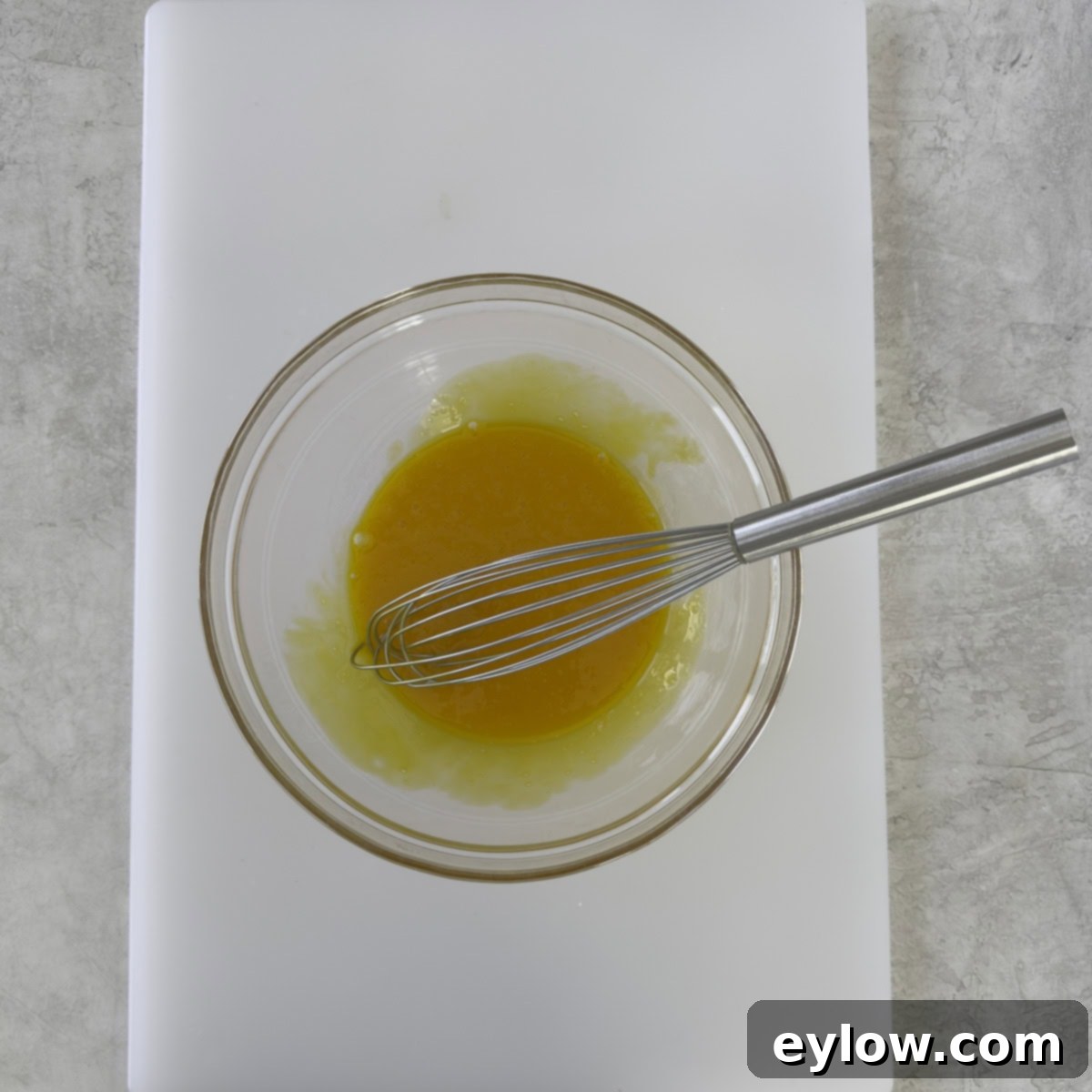
- Whisk Egg Yolks: In a medium bowl, thoroughly whisk the egg yolks until they are completely smooth and uniform in color. This ensures a consistent texture in your final curd and prevents any stringy egg bits.
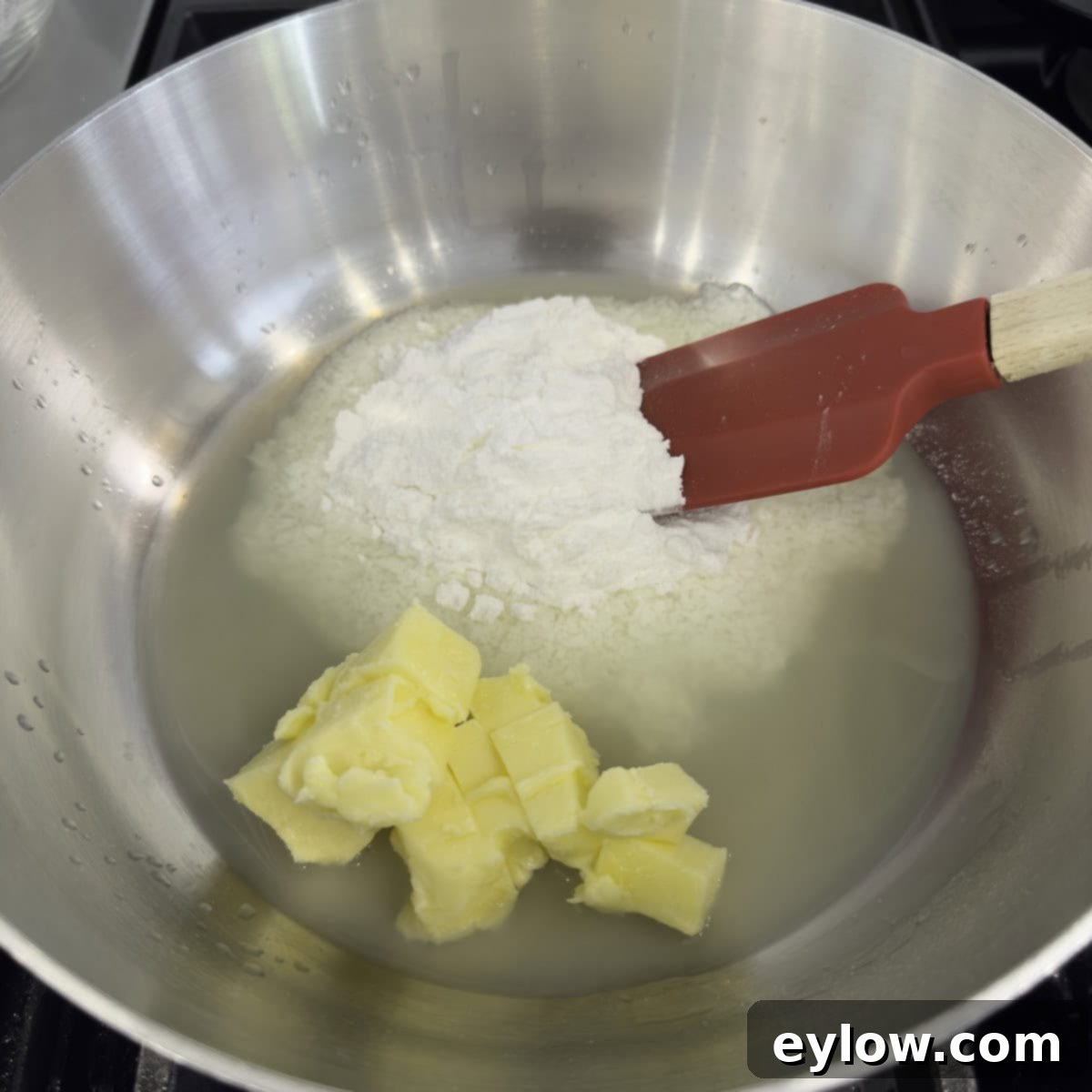
- Heat the Wet Ingredients: In a 3-quart medium saucepan (a saucier works wonderfully for this), add the fresh lemon juice, sifted allulose, and cubed butter. Heat this mixture over medium heat, whisking constantly until the butter is fully melted and the mixture is smooth and hot, but not boiling.
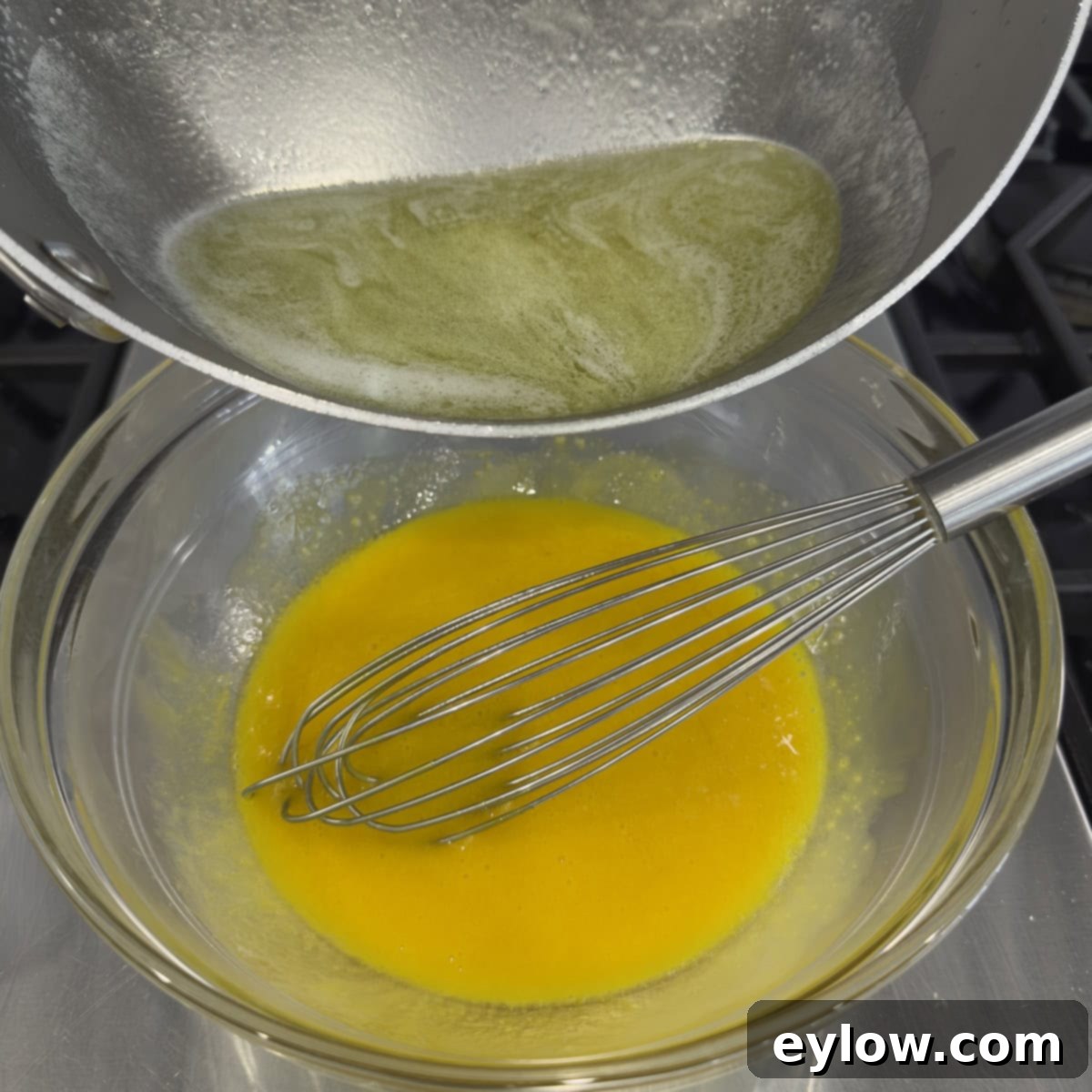
- Temper the Egg Yolks: Once the lemon-butter-allulose mixture is hot (steaming, but not boiling), slowly drizzle it into the whisked egg yolks while continuously whisking the yolks. This crucial technique, known as tempering, gradually raises the temperature of the egg yolks, preventing them from scrambling when they are returned to the hot pan.

- Cook to Thicken: Pour the entire tempered egg yolk mixture back into the saucepan. Reduce the heat to medium-low and cook, whisking continually, until the curd thickens considerably. It should coat the back of a spoon and reach a temperature of 175°F-180°F (77-80°C) on a digital thermometer, which usually takes only 1-2 minutes after tempering. Avoid boiling to prevent curdling.
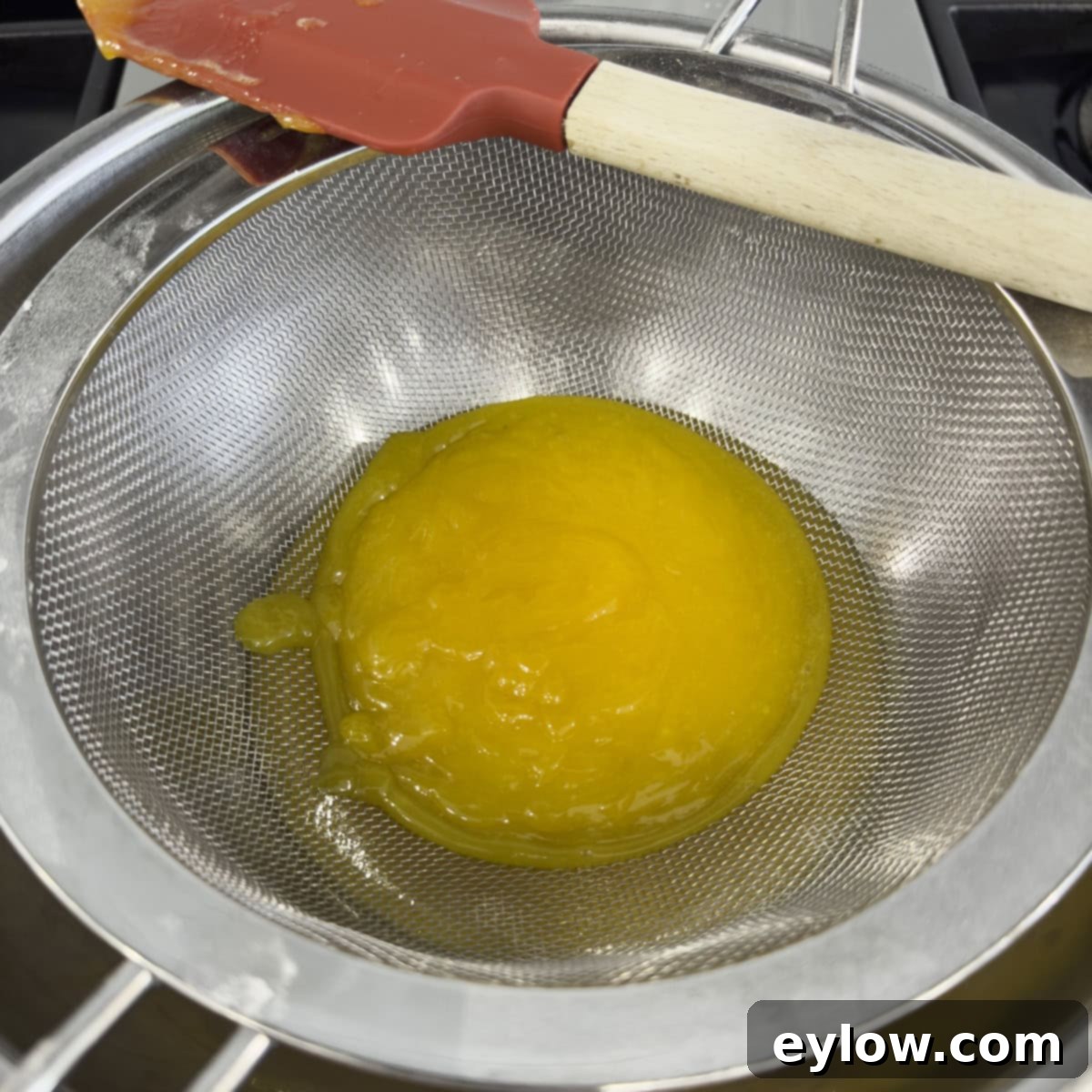
Once strained, pour the hot sugar-free lemon curd into a clean, airtight jar. Seal it tightly and refrigerate for at least 4 hours to allow it to fully thicken, or ideally, overnight. If, after chilling, your lemon curd has become thicker than your preference, simply stir in a small amount of fresh lemon juice, one teaspoon at a time, until you reach your desired pourable or spreadable consistency.
Chef’s Tip: Exploring Other Citrus Curds
While this recipe focuses on lemon, the principles can be applied to other citrus fruits! If you wish to make a curd with lime juice, for instance, it’s just as acidic as lemon juice, so the curd should thicken properly without additional citric acid. However, lime juice has a sharper, more intense flavor profile. You might find you need to adjust the amount of allulose or incorporate another complementary sweetener to balance the tartness to your taste. For a delightful twist, consider combining lemon juice and lime juice for a refreshing and vibrant lemon-lime curd!
Creative Ways to Enjoy Your Sugar-Free Lemon Curd
Once you’ve mastered this delectable sugar-free lemon curd, the possibilities for enjoying it are endless! Here are over a dozen inspiring serving suggestions to make the most of your homemade low-carb lemon curd:
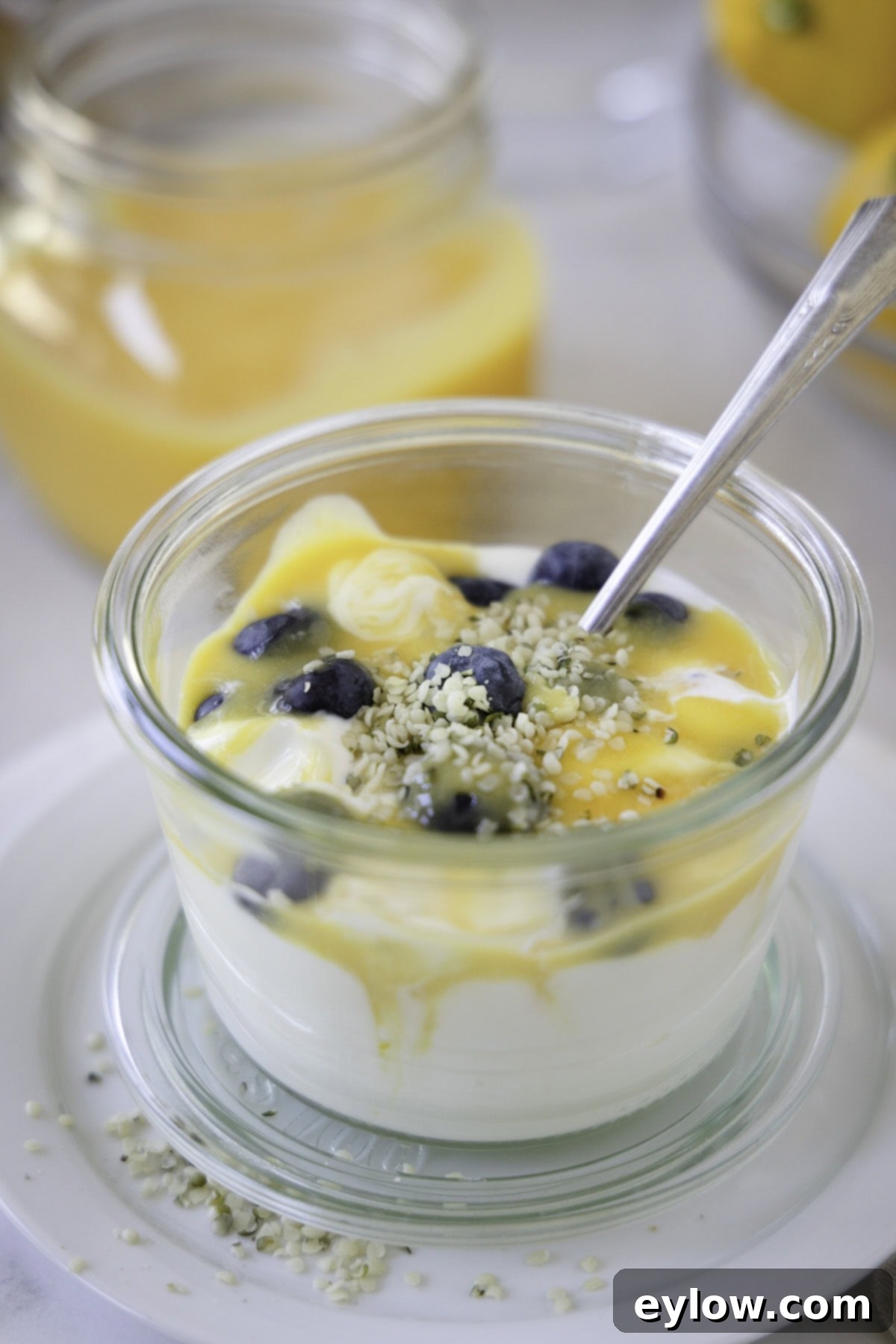
- Cake Filling Extraordinaire: Spread a generous layer between delicate cake layers for a bright, citrusy, and surprisingly light filling that elevates any celebration cake.
- Muffin & Scone Swirl: Swirl a spoonful into your favorite muffin batter before baking, or dollop it generously onto warm scones or muffins for a burst of flavor.
- Breakfast Brightener: A classic pairing, spread it on toasted bread, croissants, or even gluten-free bagels for a zesty start to your day.
- Elegant Crepe Filler: Fill delicate crepes (especially delicious with a gluten-free recipe) with this curd for an effortlessly elegant and light dessert or brunch item.
- Pancake & Waffle Topping: Elevate your breakfast stack! Top fluffy pancakes, like these hearty Buckwheat pancakes, or crispy gluten-free waffles with a dollop of lemon curd for an unforgettable treat.
- Vanilla Ice Cream Swirl: For a refreshing dessert, swirl streaks of lemon curd into softened vanilla ice cream, then refreeze for a homemade lemon ripple effect.
- Oatmeal & Overnight Oats Boost: Mix a spoonful into your morning oatmeal or high-protein overnight oats for a refreshing and tangy citrus kick.
- Yogurt Parfait Perfection: Create a vibrant lemon curd blueberry yogurt parfait layering Greek yogurt, fresh berries, and luscious lemon curd.
- Cream Puff & Tart Filling: Pipe this glorious curd into homemade cream puffs, éclairs, or mini tart shells for a sophisticated dessert that’s bursting with flavor.
- Lemon Curd Cupcakes: Core your favorite vanilla cupcakes and pipe in a generous amount of lemon curd for delightful lemon-filled cupcakes.
- Fruit & Cheesecake Drizzle: Thin the curd slightly with a little extra fresh lemon juice and drizzle it over fresh berries, mixed fruit salads, or even a classic cheesecake for an instant upgrade.
- Thumbprint Cookie Centers: Use it as a vibrant and tangy filling for your favorite thumbprint cookies.
- Gifting: Pour the cooled curd into small, decorative jars for a thoughtful and homemade gift.
Storing Your Homemade Sugar-Free Lemon Curd
Proper storage is key to extending the freshness and flavor of your delicious sugar-free lemon curd. Here’s how to keep it at its best:
According to guidelines from the National Center for Home Food Preservation, when stored correctly in a well-sealed airtight container in the refrigerator, homemade lemon curd can last for up to one month. However, in our experience, it’s so irresistibly good that it rarely lasts that long!
For longer-term storage, lemon curd freezes exceptionally well. You can freeze it for up to three months without significant loss of quality. To freeze, pour the cooled curd into a freezer-safe, airtight container, ensuring you leave at least half an inch of headspace to account for expansion. When you’re ready to enjoy it, simply transfer the container to the refrigerator and allow it to thaw slowly for 24-48 hours. Stir well before serving to restore its smooth consistency.
Speaking of lemons, one of our favorite summer grilling recipes for chicken breasts utilizes this terrific easy blender lemon marinade, bursting with fresh citrus and mint.
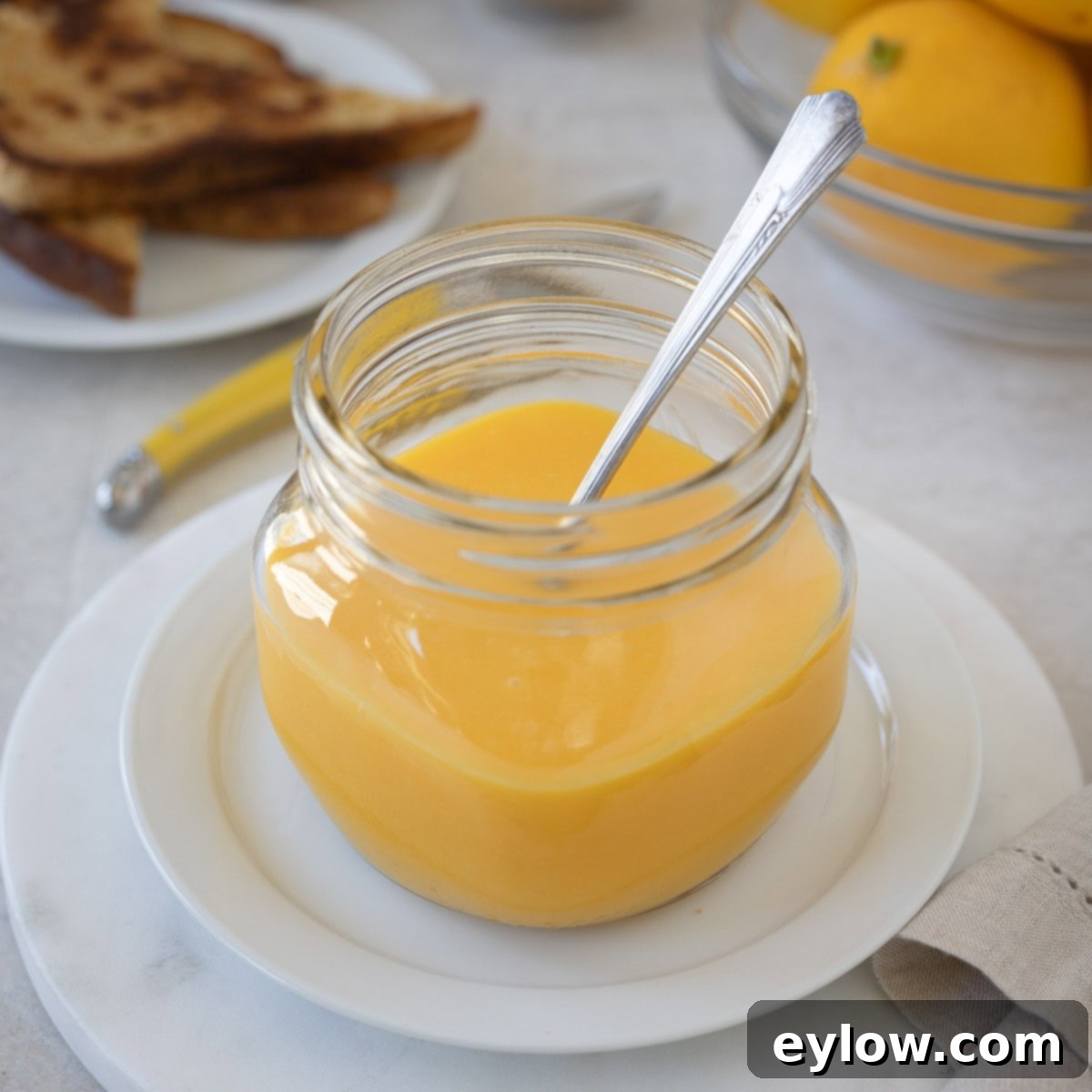
Frequently Asked Questions About Sugar-Free Lemon Curd
There are a few common reasons for a thin lemon curd. Firstly, lemon curd thickens significantly as it cools. If it still appears too thin after a full chilling period (at least 4 hours or overnight in the refrigerator), it likely wasn’t cooked long enough. Ensure you cook the mixture until it visibly coats the back of a spoon and reaches the ideal temperature range of 175°F-180°F (77-80°C) with a digital thermometer. Secondly, the type of lemon used makes a difference. Standard grocery store varieties like Eureka and Lisbon lemons have higher acidity, which aids in proper thickening. Meyer lemons, being less acidic, require the addition of powdered citric acid as outlined in the recipe to ensure they set firmly. Without it, Meyer lemon curd will be more of a pourable sauce.
Yes, you absolutely can! While butter contributes significantly to the curd’s richness, luxurious mouthfeel, and silky texture, it can be omitted or substituted. For a lighter version, or to make it dairy-free, you can use a high-quality unsalted plant-based butter substitute (like a vegan butter stick) or refined coconut oil. Keep in mind that removing butter may result in a slightly less decadent texture, but it will still be delicious and flavorful.
Simply put, no, we strongly advise against it. For the best flavor and texture in your homemade sugar-free lemon curd, fresh lemons are indispensable. Bottled lemon juice often contains preservatives and lacks the vibrant, bright, and nuanced citrus taste that fresh lemons provide. More importantly, the acidity levels in bottled lemon juice can vary greatly and may not be sufficient or consistent enough to properly thicken and set the lemon curd. The precise acidity of fresh lemon juice is crucial for the chemical reaction that creates a perfectly set curd, especially in a sugar-free adaptation.
To achieve an ultra-smooth, professional-quality lemon curd, there are two key tips. First and foremost, always strain your lemon curd through a fine-mesh sieve immediately after cooking. This essential step removes any minuscule bits of cooked egg that might have formed, as well as any lemon zest (if you chose to add it back in). Secondly, for those who prefer an absolutely uniform consistency without any textural elements, you can choose to omit the lemon zest entirely from the recipe. While zest adds a lovely aromatic complexity, leaving it out results in an undeniably silken finish.
Yes, absolutely! By using allulose as a sweetener, this lemon curd contains only 1 net carb per serving and does not cause a spike in blood sugar levels. This makes it an excellent choice for individuals managing diabetes or anyone monitoring their carbohydrate intake. However, always consult with your healthcare provider or a registered dietitian for personalized dietary advice.
Don’t discard those precious egg whites! They are incredibly versatile. You can use them to make meringues (like our Forgotten Cookies), pavlovas, angel food cake, or even simply add them to an omelet for a protein boost. They also freeze well for later use.
Yes, this sugar-free lemon curd is perfect for making ahead! In fact, it needs time to chill and fully set in the refrigerator for at least 4 hours, or ideally, overnight. This makes it an excellent component for meal prep or for preparing desserts in advance for parties or special occasions. Its flavor often deepens slightly after a day or two in the fridge.
More Lovely Lemon Recipes to Brighten Your Day
If you adore the refreshing and versatile flavor of lemon as much as we do, you’re in for a treat! Here’s a collection of both sweet and savory lemon recipes that are sure to inspire your culinary adventures. From vibrant main dishes to delightful desserts, these recipes harness the sunny goodness of this incredible citrus fruit.
- Easy Blender Lemon Chicken Marinade
- Lemony Mediterranean Pasta Salad Recipe
- Super Moist Lemon Olive Oil Cake Recipe
- Homemade Lemon Custard Ice Cream
Did You Make This Delicious Sugar-Free Lemon Curd?
We absolutely love hearing from you! If you tried your hand at making this sugar-free lemon curd, please take a moment to add your comment below. Your feedback is invaluable and we always enjoy connecting with our readers. If you loved this recipe as much as we do, please consider leaving a 5-star rating! Your ratings truly help other readers discover and enjoy this incredible low-carb, keto-friendly treat.
📖 Recipe

Sugar-free Lemon Curd
Sally Cameron
Pin Recipe
Equipment
-
Fine-mesh strainer
-
3-quart saucepan We highly recommend a saucier for its rounded sides, which make whisking easier and prevent scorching—a great addition to your kitchen collection!
-
Whisk
-
Microplane zester
-
Citrus juicer (electric or hand juicer)
-
Digital kitchen thermometer
Ingredients
- 4 tablespoons unsalted butter (sub plant-based butter or refined coconut oil for dairy-free)
- ¾ cup pure powdered allulose, sifted well (do not use allulose blends with monk fruit or erythritol)
- 6 large egg yolks
- 2 large lemons, juiced and zested (yields approximately ½ cup juice; zest is optional for texture)
- ¼ teaspoon powdered citric acid (use only if using Meyer lemon juice to ensure proper setting)
Instructions
Prep work
-
Carefully separate the eggs, reserving the yolks for the curd and saving the whites for another delicious recipe (like meringues!). Sift the powdered allulose thoroughly, as it often contains lumps that need to be broken up for a smooth result. Zest your lemons first, then juice them. It’s important to strain the fresh lemon juice to remove any pulp or seeds; you’ll need exactly ½ a cup of lemon juice for this recipe.
Cook the lemon curd
-
In your saucepan (a saucier works best), melt the butter over medium-low heat. Once melted, add the strained lemon juice (and the ¼ teaspoon citric acid if you are using Meyer lemons) and the sifted allulose. Whisk continuously until the mixture is completely smooth and the allulose has fully dissolved. Meanwhile, in a separate medium bowl, whisk the egg yolks until they are smooth and light.
When the butter-lemon-allulose blend in the saucepan is hot and steaming (but not boiling), slowly and steadily drizzle about half of this hot mixture into the whisked egg yolks, whisking continually and vigorously. This process, called tempering, gently raises the temperature of the egg yolks, preventing them from scrambling when combined with the remaining hot liquid.
-
Pour the entire tempered egg yolk mixture back into the saucepan with the remaining hot liquid. Reduce the heat to low-medium and cook, whisking continually with a silicone whisk, until the curd thickens significantly. It should coat the back of a spoon and reach a temperature of 175°F-180°F (77-80°C) on your digital kitchen thermometer. This usually takes about 1-2 minutes of gentle cooking after tempering. Immediately pour the cooked lemon curd through a fine-mesh sieve into a clean bowl to catch any tiny cooked egg bits or un-melted zest, ensuring an ultra-smooth consistency. If you desire, stir in 1 tablespoon of fresh lemon zest at this point for enhanced flavor and aroma.
-
Once strained, pour the liquid lemon curd into a clean, airtight jar. Seal the jar tightly with a lid and refrigerate for a minimum of 4 hours, or ideally, overnight, to allow it to fully set and thicken.
If, after refrigeration, your sugar-free lemon curd is thicker than you prefer, simply whisk in a little fresh-squeezed lemon juice (start with ½ teaspoon, then add more gradually) until you achieve your desired smooth, spreadable, or pourable consistency.
-
This homemade lemon curd keeps beautifully! Store it in an airtight container in the refrigerator for up to one month, or freeze it for up to 3 months for longer storage. To thaw, simply place the frozen container in the refrigerator for 24-48 hours and stir well before serving to restore its texture.
Notes
Understanding Carbs: Although allulose packaging may list carbohydrates, our bodies do not metabolize allulose as a caloric sugar. Therefore, the net carbs from allulose in this recipe are zero. The only minimal carbs present come from the natural lemon juice itself. This makes our lemon curd a truly low-carb and keto-friendly option.
Meyer Lemon Acidity: If you choose to use Meyer lemon juice, you absolutely must boost its acidity to ensure the curd sets properly. Add a ¼ teaspoon of powdered citric acid to the allulose after measuring it out, before combining with other ingredients.
Creative Use for Extra Egg Whites: Don’t let those egg whites go to waste! They are perfect for making delightful desserts like these Forgotten Cookies (which are essentially light and airy chocolate chip meringue cookies).
